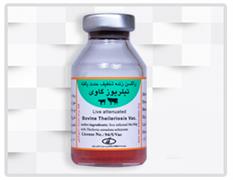The type and form of vaccine:
Live attenuated, cell suspension, injectable
Vaccine composition:
Each dose of vaccine (1 ml) contains:
- A minimum of 1×106 live infected monocytes/macrophages with Theileria annulata schizonts (strain SI5).
- Glycerol as a cryoprotective agent
- Normal bovine inactivated, PEG treated and gamma irradiated serum
Indication:
For active immunization of susceptible exotic or cross-breed cattle against tropical theileriosis
Administration route and dosage:
Withdraw vial(s) from liquid nitrogen container and put it in a simple box for 1-2 minutes and let the liquid nitrogen evaporate completely (wearing gloves and face shield are recommended), then let it to be fully thawed ( for better achievement, put the vaccine in tepid water [37 °C] for a few minutes ).
Shake the vial gently before administering a dose of vaccine. Then, load syringe with vaccine and inject subcutaneously 1 ml of vaccine for each cattle/calf in front of the shoulder using aseptic technique.
Recommended vaccination program:
- The bovine theileriosis vaccine is specifically recommended between late autumn until end of winter. Before the vector tick season activity begins.
- The bovine theileriosis vaccine is approved for use in calves of three-months of age and older.
Withdrawal period:
Meat consumption should be avoided 21 days after vaccination,
Contraindications:
- Calves of less than three- months of age and heavy pregnant cow (over 7 months of pregnancy)
- During ten days after giving birth
- During the season of tick activity (mid-spring to early autumn in Iran)
- Sick and weak animals and those with febrile illnesses
- Three weeks prior to slaughter
Side effects:
- Anaphylactic reactions may rarely occur in susceptible breeds. In such cases antihistamine and adrenaline is recommended under the supervision of a veterinarian.
- Bovine theileriosis vaccine is generally well tolerated, but local reactions at the injection site, such as swelling of local lymph nodes and slight and transient fever can occur, possibly due to the serum and or allogeneic vaccinal cell line. Normally, they are slight and disappear spontaneously within a few days.
Drug interactions:
Simultaneous administration of immunosuppressive drugs or other vaccines two weeks before and after taking the bovine theileriosis vaccine must be avoided.
Precautions and warnings:
- Bovine theileriosis vaccine must be administered according to the national immunization schedule.
- Vaccine must be provided from official distributer and be administered under the supervision of a veterinarian.
- The aseptic technique should be used during vaccine injection.
- Shake the vial before injecting a vaccine dose to ensure the uniformity of vaccine cell suspension.
- The vaccine must be administered within one hour of thawing.
- Do not refreeze the vaccine once thawed.
- All the healthy susceptible calves and cattle must be concurrently vaccinated.
- Consider two hours for resting before and one day post-vaccination for recovery and do not transport the vaccinated animals.
- The efficacy of vaccine is deeply enhanced in cattle while ticks were controlled by application of acaricides via dipping or spraying.
- Use of adequate personal protective equipment (glasses, gloves, safety boots/shoes and coveralls) is recommended during vaccine administration.
- If the operator experienced a needlestick or sharps injury during the course of work, immediately wash needlesticks with soap and water and seek medical treatment.
Storage:
Vaccine vials should be stored and delivered in deep freeze condition (-70 °C) or in liquid nitrogen (-196 °C) and kept away from sunlight. The vaccine can be administered until the expiration date printed on the label (one year after manufacturing date).
Safe disposal of waste/ partially used vaccines:
All used vaccine vials and disposable syringes should be kept in a safety box and properly sterilized (by autoclaving, burning and appropriate chemicals) and in a sanitary landfill.
Presentation:
Each vial contains 12 doses of vaccine.
Last reviewed:
11.2015
References:
1- Office international des epizooties (op, 20-14, Manual of diagnostic tests and vaccine for terrestrial animals, chapter 2.4.16.
2- Hashemi, Fesharaki R., 1988, Control of Theileria annulata in Iran, Parasitology Today, 4(2):36-40
3- Hashemi, Fesharaki R., 1998, Recent development in control of Theileria in Iran, Parasite 5(2):193-6
 Related Products
Related Products Related News
Related News Related Articles
Related Articles Bovine Theileriosis Vaccine
Bovine Theileriosis Vaccine
